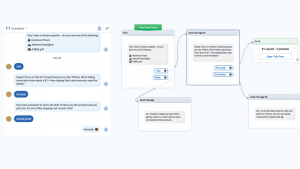As part of our ongoing series of social media for today’s one-man-band marketers and those who love them, we’ve been looking at Instagram, both why and how to use it.
Last week, we covered some of the benefits of marketing with Instagram. We’ll continue that today.
As often happens in life, we will uncover some of the shadow-side aspects of Instagram for marketers.
Instagram offers a nigh-on unlimited text character count. (2200tc)
As we know from Twitter, “tc” means text character and includes punctuation and spaces. Instagram gives you over 2000 more of those little buggers than Twitter allows. That’s definitely a boon to brands who can use that space to share their story.
Likewise, it’s a benefit to users and a very smart move by the platform to limit it there. That way, they don’t need to worry about users getting turned off by unchecked soapboxing and grandstanding.
I’m a writer, and even I couldn’t envision what 2200 text characters looked like. So, I tried what I thought would be a quick experiment. This is where we begin to encounter the shadow-side, at least as marketers.
An exercise in why Instagram isn’t the easiest to work with as a marketer
Namely, because it’s not meant to be. It’s meant for the individual person living their daily life.
As shorthand, that human is often referred to as a “consumer” — a consumer of content, photos, that is, and eventually, of products and services they find through their double-tapping (or “hearting” of said photos).
Like Twitter and other platforms, Instagram started out as a fun way to share your life moments with friends. Not for brands, but for individuals.
But, like the kids say, Haters gonna hate. Brands gonna brand. Platforms gonna monetize. And, here we all are.
So what does 2200tc look like on Instagram?
On a mobile device, you can only see the first three lines and you have to click to see the rest.
Question: Why wasn’t this a quick demo to post to Instagram?
Short Answer: Because it’s a mobile app
Until I had a client early last year willing to pay me to run their Instagram account, I was content to sit that one out.
For one, because I have a life, thank you very much.
For two, I don’t have to take photos of my every meal or flower blooming.
Feel free to add any of the snarky reasons you’ve heard or made against the rampant “social media-ification” of our lives. Hashtag-buying-a-toothbrush-at-the-store.
And, lastly, because it’s only mobile. (Of course, now I’m hooked.)
Long Answer: That means you HAVE to post from a mobile device
I know that’s putting a really fine — perhaps obvious — point on it. But, I kid you not, I knew this and still goofed around with this silly little experiment like a noob. (Which I’m not anymore, B. T. Dubs.)
Now sit right back and you’ll hear a tale, a tale of a fateful trip … A three-hour tour, a three-hour tour.

Step One: Get some loooooong content.
Instead of a lorem ipsum or maybe a bacon ipsum word generator, I googled up some of the longest sentences in American literary history. I couldn’t use all Faulkner without cutting him off mid-sentence. I had been hoping he’d have one single sentence which would slot in at 2150tc. No such luck from the Yoknapatawpha contingent.
Step Two: Count your content to make sure it’s long enough.
I copied and pasted passages from Faulkner, Woolf, and Dickens until I got close enough, according to lettercount.com.
Step Three: Then, because I didn’t want to type all that with my two thumbs, I copied and pasted those into an email to myself from my laptop. The email had line breaks. (As of May this year, iOS users can’t put line breaks; e.g., paragraphs; in their Insta-posts. Android users can. Big shrugs all around.)
Step Four: Next, I switched to my smartphone because you can only post to Instagram from a mobile device.
Step Five: From my smartphone’s email reader, I copied and pasted the Faulkner/Woolf/Dickens passages to the clipboard.
But you can’t post just words. It’s a visual platform. There has to be an image. So…
Step Six: I made a happy little drawing with markers and snapped a photo of it.
Anybody else bored yet? And to think, I remember when you had to buy flash bulbs separately and send your film out to be developed. Cheers to progress.
It’s way easier to post latte art and craft beer, I’m just saying. And that’s the platform’s point — it was originally for the user, not for brands. (Or, according to the aluminum foil hat crowd, it was created as a crowd-sourced database whereby the public willingly submits to be scanned for facial recognition.) Half-of-one, six dozen of the other, what’s on TV tonight?
Step Seven through Nth: I posted the picture. Pasted the words from the clip to the new Insta-update. Had room; i.e., text characters, left over. So I added the source link for these quotes. Added some hashtags. Still had room left over and that’s why you’ll see me counting the spaces I had left at the very bottom of the post.
Speaking of hashtags, Instagrammers go bigger and broader
It’s different than Twitter, obviously, because there’s loads more room. #Youcantagasstreamofconsciousness.
That’s a benefit for marketers. You can tag whole user communities, to find them, join them, engage them. Here’s a good write-up from Social Media Examiner to get you started with “proper” hashtagging in Instagram.
A drawback for marketers on Instagram: Hyperlinks aren’t allowed in posts
You probably noticed that the source link in my 2200-tc post isn’t clickable. The only link Instagram lets you have is in your profile.
That’s why, at least for the posts that are selling things, you’ll often see their captions close with the phrase, “link in bio.” Here’s Hubspot to coach you on writing great Instagram captions.
Free tip to beach-lit mystery novel writers out there — Link in Bio would make a killer title.
Did I mention you can sell from within the post?
Why, yes I did.
Traditionally, it’s been a bit of a back-door, workaround approach. The same with post “scheduling” — it can be done, but it’s not as straightforward or easy as other platforms.
I suspect that’s because they’ve been tetchy about their API-integration. Perhaps to keep it a more user-not-brand-centric experience.
That’s why I’m really jazzed to go read this two-week old post by Kevin J. Ryan at Inc. magazine about the new business features recently announced, but not quite yet available.
Next week, we’ll look at some of the ways you can “sell” in your Instagram posts.
Gilligan / actor Bob Denver photo credit: By CBS Television; Public Domain; via Wikimedia Commons
Digital & Social Articles on Business 2 Community(13)








